Butterflies and Moths
Media
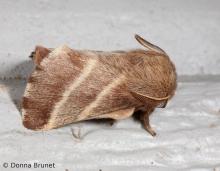
Species Types
Scientific Name
Malacosoma americana
Description
The silken tents of eastern tent caterpillars are conspicuous each spring in the forks of apple, cherry, and plum trees. The adult moths are brown with two pale stripes on the forewings.
Media
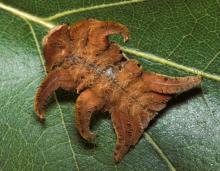
Species Types
Scientific Name
More than 20 species in Missouri
Description
Adult slug caterpillar moths are heavy-bodied and furry. The weird-looking caterpillars have suckers instead of prolegs, so they glide around like slugs. Don’t touch — many have stinging spines or hairs.
Media
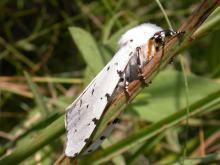
Species Types
Scientific Name
Estigmene acrea
Description
The salt marsh moth, a type of tiger moth, is strikingly white with small black spots. Males have yellow-orange hindwings. The caterpillars are fast-moving woolly bears ranging from yellowish to brown to blackish.
Media

Species Types
Scientific Name
Halysidota tessellaris
Description
Adult banded tussock moths have a distinctive checkered pattern on the wings. The fuzzy, dirty gray caterpillars are more familiar, with their pencils or tussocks of longer, black and white hairs.
Media

Species Types
Scientific Name
Utetheisa ornatrix
Description
The ornate bella moth, also called the calico moth and rattlebox moth, is one of Missouri’s most attractive moths. The colors, however, are a warning to predators that this moth is toxic if eaten. Even spiders reject them.
Media

Species Types
Scientific Name
Deidamia inscriptum
Description
The lettered sphinx is the earliest of our sphinx moths to emerge in springtime and may be seen starting in March and April. This single-brooded resident uses wild grapes, Virginia creeper, and peppervine as its caterpillar food plants.
Media

Species Types
Scientific Name
Megalographa biloba (formerly Autographa biloba)
Description
The bilobed looper moth has a conspicuous B-shaped silvery spot on each forewing. Caterpillars of this noctuid moth eat a wide range of plants, and this species is widespread.
Media

Species Types
Scientific Name
Erynnis juvenalis
Description
Juvenal’s duskywing is a spread-wing skipper that closely resembles Horace’s duskywing. Unlike Horace’s, it flies only in springtime and has two small telltale pale spots on the hindwing underside.
Media

Species Types
Scientific Name
Thorybes pylades
Description
A cloudywing is a spread-winged skipper whose ground color, seen from above, is completely dark, and not mottled. The northern cloudywing has a dark face, too.
Media

Species Types
Scientific Name
Erynnis horatius
Description
Look for Horace’s duskywing at flowers and mud puddles, in forests, and along roadsides.
See Also
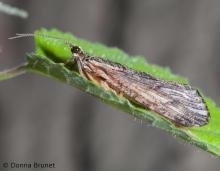
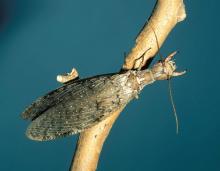
Media

Species Types
Scientific Name
About 1,500 species in North America north of Mexico
Description
Adult caddisflies are mothlike. Their larvae are aquatic and build portable, protective cases out of local materials, including grains of sand, bits of leaves and twigs, and other debris.
Media

Species Types
Scientific Name
Corydalus cornutus
Description
Adult eastern dobsonflies are huge and mothlike, with large wings and a weak, fluttery flight. The fiercely predaceous aquatic larvae, called hellgrammites, are well-known to anglers, who often use them as bait.
About Butterflies and Moths in Missouri
Butterflies, skippers, and moths belong to an insect order called the Lepidoptera — the "scale-winged" insects. These living jewels have tiny, overlapping scales that cover their wings like shingles. The scales, whether muted or colorful, seem dusty if they rub off on your fingers. Many butterflies and moths are associated with particular types of food plants, which their caterpillars must eat in order to survive.





















